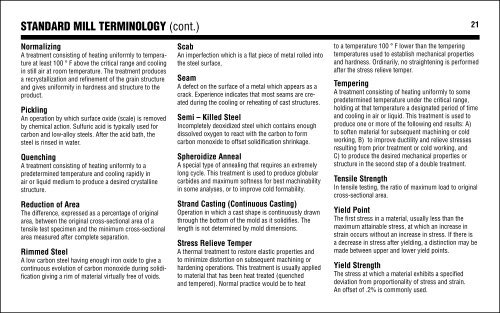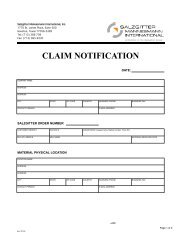BLESS OILFIELD SERVICES, INC. - Salzgitter
BLESS OILFIELD SERVICES, INC. - Salzgitter
BLESS OILFIELD SERVICES, INC. - Salzgitter
You also want an ePaper? Increase the reach of your titles
YUMPU automatically turns print PDFs into web optimized ePapers that Google loves.
STANDARD MILL TERMINOLOGY (cont.)<br />
21<br />
Normalizing<br />
A treatment consisting of heating uniformly to temperature<br />
at least 100 ° F above the critical range and cooling<br />
in still air at room temperature. The treatment produces<br />
a recrystallization and refinement of the grain structure<br />
and gives uniformity in hardness and structure to the<br />
product.<br />
Pickling<br />
An operation by which surface oxide (scale) is removed<br />
by chemical action. Sulfuric acid is typically used for<br />
carbon and low-alloy steels. After the acid bath, the<br />
steel is rinsed in water.<br />
Quenching<br />
A treatment consisting of heating uniformly to a<br />
predetermined temperature and cooling rapidly in<br />
air or liquid medium to produce a desired crystalline<br />
structure.<br />
Reduction of Area<br />
The difference, expressed as a percentage of original<br />
area, between the original cross-sectional area of a<br />
tensile test specimen and the minimum cross-sectional<br />
area measured after complete separation.<br />
Rimmed Steel<br />
A low carbon steel having enough iron oxide to give a<br />
continuous evolution of carbon monoxide during solidification<br />
giving a rim of material virtually free of voids.<br />
Scab<br />
An imperfection which is a flat piece of metal rolled into<br />
the steel surface,<br />
Seam<br />
A defect on the surface of a metal which appears as a<br />
crack. Experience indicates that most seams are created<br />
during the cooling or reheating of cast structures.<br />
Semi – Killed Steel<br />
Incompletely deoxidized steel which contains enough<br />
dissolved oxygen to react with the carbon to form<br />
carbon monoxide to offset solidification shrinkage.<br />
Spheroidize Anneal<br />
A special type of annealing that requires an extremely<br />
long cycle. This treatment is used to produce globular<br />
carbides and maximum softness for best machinability<br />
in some analyses, or to improve cold formability.<br />
Strand Casting (Continuous Casting)<br />
Operation in which a cast shape is continuously drawn<br />
through the bottom of the mold as it solidifies. The<br />
length is not determined by mold dimensions.<br />
Stress Relieve Temper<br />
A thermal treatment to restore elastic properties and<br />
to minimize distortion on subsequent machining or<br />
hardening operations. This treatment is usually applied<br />
to material that has been heat treated (quenched<br />
and tempered). Normal practice would be to heat<br />
to a temperature 100 ° F lower than the tempering<br />
temperatures used to establish mechanical properties<br />
and hardness. Ordinarily, no straightening is performed<br />
after the stress relieve temper.<br />
Tempering<br />
A treatment consisting of heating uniformly to some<br />
predetermined temperature under the critical range,<br />
holding at that temperature a designated period of time<br />
and cooling in air or liquid. This treatment is used to<br />
produce one or more of the following end results: A)<br />
to soften material for subsequent machining or cold<br />
working, B) to improve ductility and relieve stresses<br />
resulting from prior treatment or cold working, and<br />
C) to produce the desired mechanical properties or<br />
structure in the second step of a double treatment.<br />
Tensile Strength<br />
In tensile testing, the ratio of maximum load to original<br />
cross-sectional area.<br />
Yield Point<br />
The first stress in a material, usually less than the<br />
maximum attainable stress, at which an increase in<br />
strain occurs without an increase in stress. If there is<br />
a decrease in stress after yielding, a distinction may be<br />
made between upper and lower yield points.<br />
Yield Strength<br />
The stress at which a material exhibits a specified<br />
deviation from proportionality of stress and strain.<br />
An offset of .2% is commonly used.




